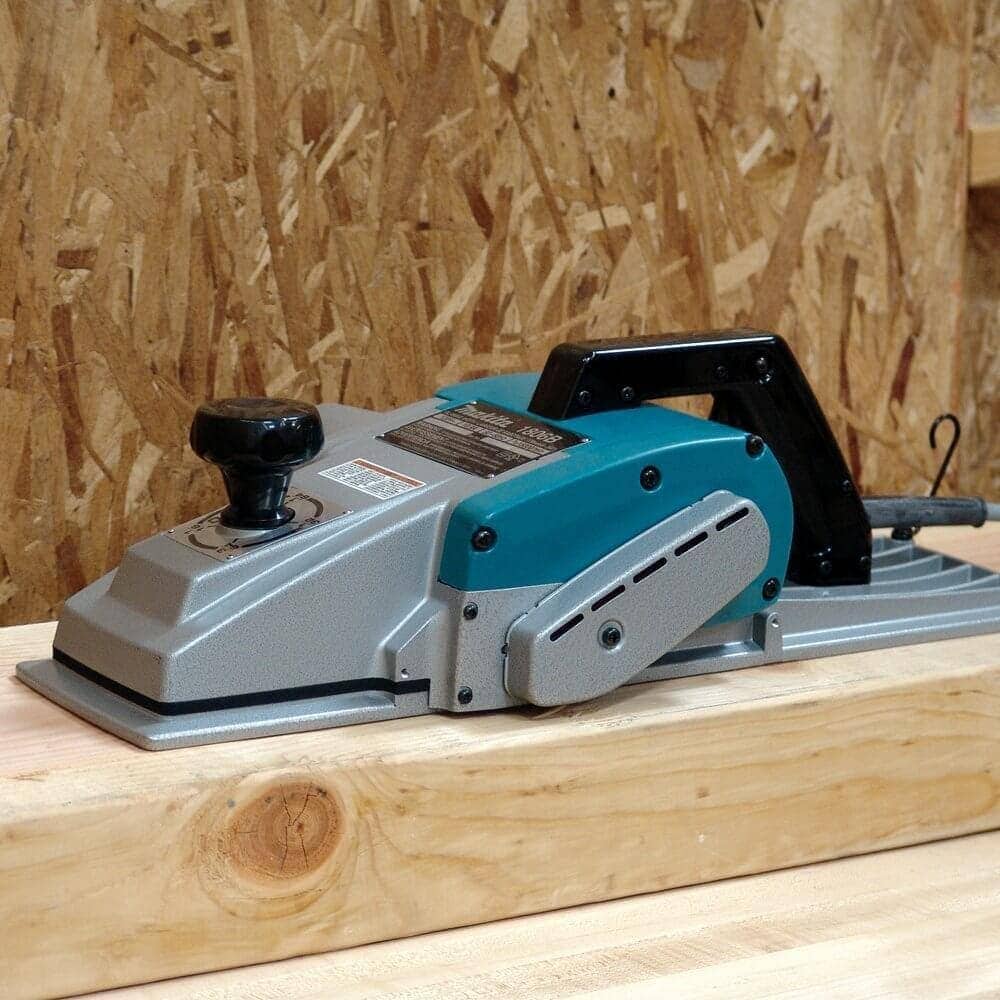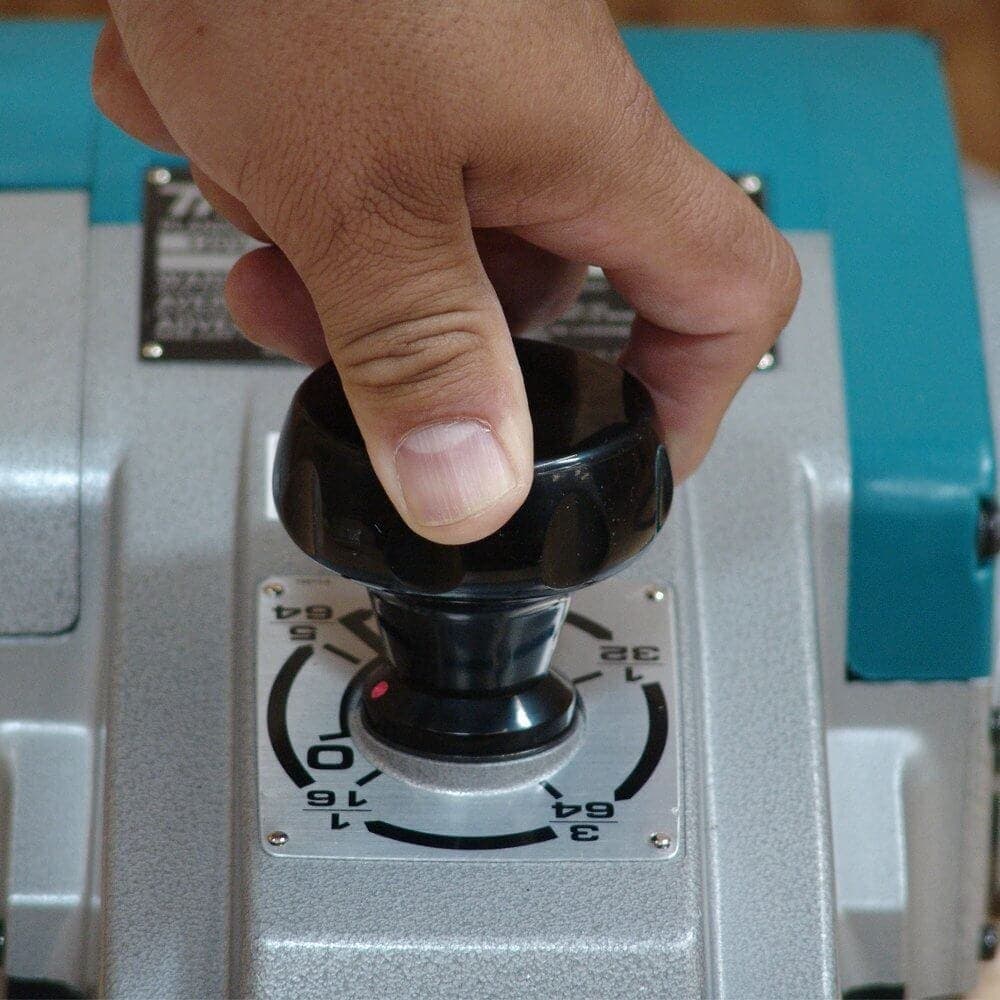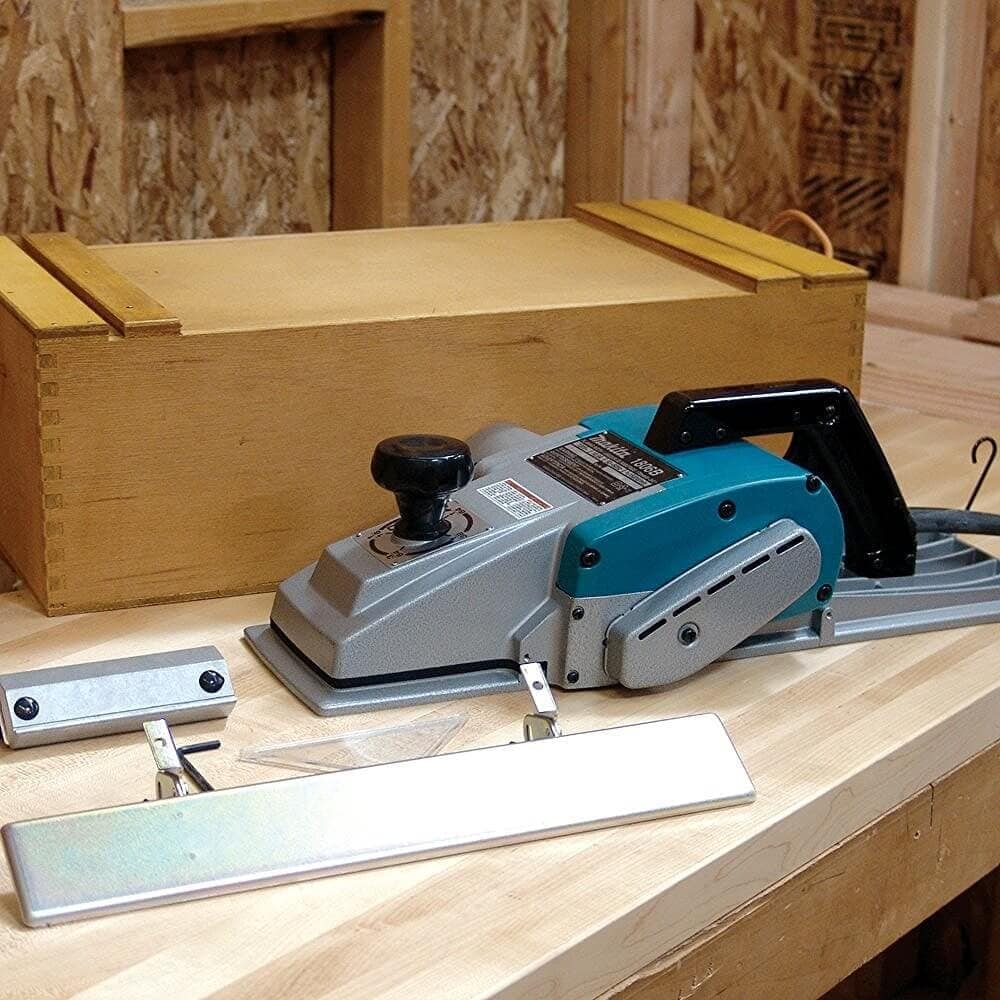Don’t let the simple look of the powerful Makita 1806B 10.9 amp, 6-3/4-inch planer fool you. It’s a rugged and powerful tool that’s ideal for timber framing. You can easily dress timbers and use this tool to square up timbers before layout. Here are some of the most important things to know before you buy it.
Precision
One of the best things about this planer is its precision. You can adjust the depth easily for consistent and razor-sharp accuracy on each beam. The cut quality is excellent for tougher woods like oak and makes quick work of softwoods.
Control
You’ll be pleasantly surprised at how easy this tool is to control when you use it. Since it’s so stable and heavy, you won’t notice much difference between cutting soft or hard woods. There’s minimal vibration because of the weight and sturdiness of the tool. The result is a much smoother surface the first time around and in a much shorter amount of time.
Features And Specs
These are the main specs and features:
- 15,000 RPMs
- 30,000 cuts per minute
- Multiple depth adjustments
- Lock-on button for continuous operation
- Sturdy sole plate
- Double insulation
- Comfort handle
- Swing-down blade protector
- Two-blade cutter head
- Aligned grips for added control
- Maximum cut size of 6.75 inches
If you buy the tool new, it also comes with a blade set, multiple rule guides, a wrench, a sharpening holder assembly and a really nice wooden case.
Weight
For some people, one of the minor disadvantages of this tool may be its weight. If you’re expecting a light tool, you’ll be disappointed. However, you’d be even more disappointed if you bought a cheap lightweight planer. Part of what makes this tool so precise and easy to control is its solid construction.
If you want to avoid arm fatigue, the best way to use it is to make small cuts. Also, don’t forget to wax the base and keep it clean.
Cost
This planer is definitely not the cheapest and may not be immediately affordable for shoppers with tight budgets. Even if you need to postpone a little while to make a purchase, this tool is definitely worth the wait. .
With the long-lasting durability of a Makita and the overall usefulness of this power-packed planer, your investment is worth every penny. You could buy a different smaller planer for one-half of the price. However, the performance and quality you’d get from it would be about one-third of what you get from this planer. Also, Makita offers a great year-long warranty if you buy the tool new.
Should I Buy It?
If you’re considering buying it, if you need an above-average planer and if you have the funds, you absolutely should buy it. This tool does everything it’s supposed to and will probably even exceed your expectations. Also, it’s built to be resilient enough to last a long time whether it spends most of its time on your tool shelf or on the work table.
Please note:
Timber Frame HQ is a participant in the Amazon Services LLC Associates Program, an affiliate advertising program designed to provide a means for us to earn advertising fees by advertising and linking to amazon.com. When you purchase something within 24 hours from Amazon, a small percentage of the sale goes to support the efforts of TFHQ.



I bought this one last year for our log cabin build, very happy with it. One does get a work out with it.lol
A workout indeed but worth it. Thanks.
The biggest drawback to this tool is that it does not have a carbide blade. Disassembly for sharpening is a multi-step process, and getting the tool back in running order will take about 40 minutes. For this reason alone, I have used it less and less in my timber-framing. When rough sandpaper on an 8″ circular wheel won’t cut it fast enough, I just use a 4″ electric planer with reversible carbide blades. Overall, a better and cheaper solution. I have used an 1806B for 18 years now–this is not an unconsidered post. This is a quality tool, but it has its shortcomings, which were not (other than the weight) noted in the review above.
Thanks for your feedback and great point. I have not found that I needed to change the blades out that frequently to be a hassle however, it has mostly been used on softwoods and not a hardwood. I have my tried and true 3 1/2″ planer as well, it is a workhorse, but it is handy that you can clean up something that is 12″ wide in two passes especially, when tiring to square something up.
This one or the 12″ Makita… I have access and worked with eh 12″ model, but I sometime think it is over kill on 5 to 10 inch timbers, what would you buy if you could buy only one?
Cheer
The 12″ is an overkill beast of a tool but well worth the money if you can swing it. It weighs in close to 50 lbs but make quick work of cleaning up timbers. Planning on reviewing the Makita and Mafell in a future article.
Good point about hard woods and soft woods. I do quite a bit of oak, as it turns out, and even the pine I work with is pretty knotty..
Is it a trouble to do 8 or more inch timbers with the planer?
It can be a little troublesome at times, you will need to make two passes and the cuts can be off from one another, if you can afford it and are cutting more than a couple frames it go with a 12″ planer otherwise, this one will get the job done.
I have the funds to buy the 1806B but am anxious about the cost to buy the KP312. The majority of my timbers are 8x10s with the occasional 10×14. My issue is that I am a busy with my career and timber framing is a hobby (building 3 timber structures over the next three years), so I’m looking for efficiency. Brice’s comment on the two pass on a 12″ timber makes is sound easy. Can a beginner like myself get a good enough face on a 10 or 14″ face with the 1806B?
I am also milling my own timbers with a logosol chainsaw mill and although the finish is pretty good I do want a nice smooth finish to avoid collecting dust.
Appreciate any tips and advice.
simon
The big Makita KP312 is a great machine and worth every penny of it, but with only 3 frames I think you could get away with the 1806B. You will have overlap marks in the middle of the timbers that you will need to sand out.
If you have a long beam, do you have to start planing in the high spot (crown)? Given how short the planer is, it seems if you start at one end of, say, a 12 foot timber, by the time you get to the other end you will have just created a smooth surface but with nearly the same crown as the timber began with. Am I wrong? Or should you snap a string line and start planing at the highest spots to get it down to a near consistent surface before planing from end to end/
Has anyone found a adaptor to hookup to a dust collection for a MAKITA 6-3/4″ PLANER,
I have seen someone set up a PVC pipe system
Love the planer, yet, I am trying to find a link to a shop manual for it.
Any luck?
Thank you!
We found the instruction manual here
Here’s a thought. While Makita makes a 6 3/4″ wide planer, Triton makes a 7″ hand planer at a fraction of the cost.
I’ve read mixed reviews just like any other ticket item, you get your great to your poor ratings on them, so it’s hard to get a good read on what the product is truly like.
So, is it possible to do a comparison between the two and give us your best and honest assessment? I, myself, choose to buy quality tools, especially if it’s going to be used in precision work. I don’t want to skimp on a tool only to clean that it’s junk and I will have to go out and purchase something else. If I were a professional, then I’d out for the more expensive unit, but I’m a hobbyist.
A cheap man pays twice.
Triton has a 7″ planer at a fraction of the cost and 15 amps. That being said, I’m not sure how it compares to the Makita which I would suspect is a better built tool? I think that for the amount of work I do, as I am a hobbyist, I believe that I can make do with the Triton at the cheaper price tag and hope for the best. My dad used to say that a cheap man pays twice. Let’s hope that this isn’t the case. Cheers!
Just an update from my previous comment about the Triton 7″ planer. It’s not 15 amps but 12.5 amps. Sorry about the error. Cheers!
I am really struggling to decide between this and the Triton. Triton has a newer version of their 7″ planer TPL180B that is now 14 amps. The older 12.5 amp is still available. Reviews are very favorable overall, but some people complain about blade changing, while others say blade changing is fine. Argh! I just need to flatten some slabs a few times a year. I will never use the planer for extensively, but I do like to get the best tools…
Either is a good tool. I haven’t much experience with Triton but have heard good things about it.